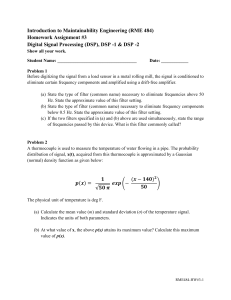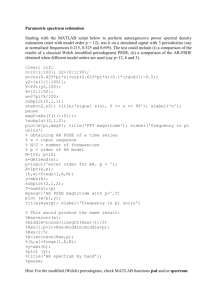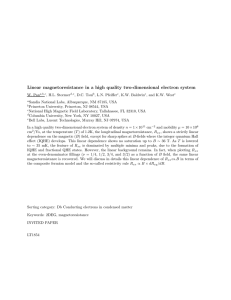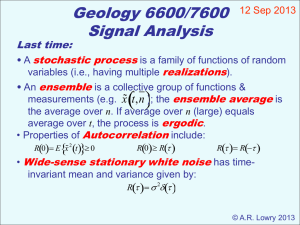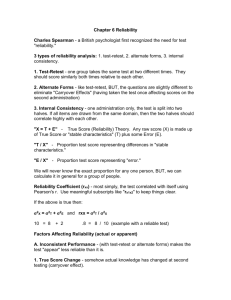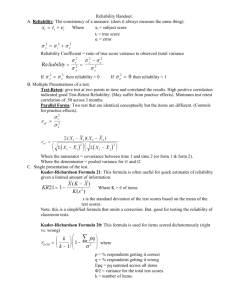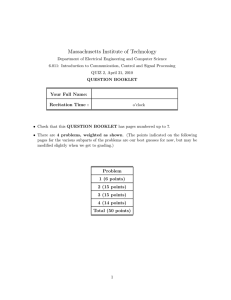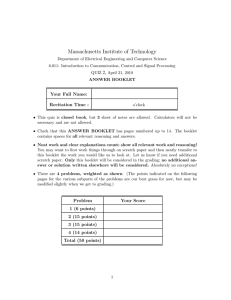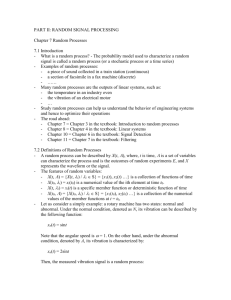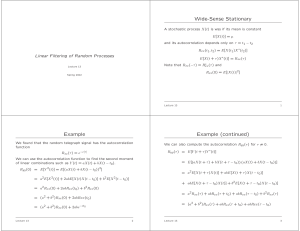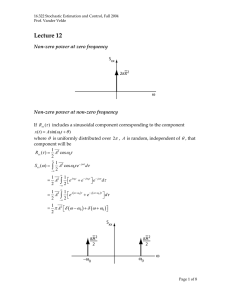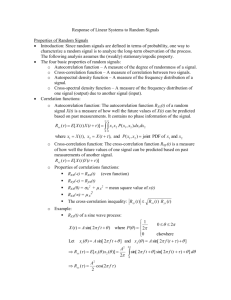EE 571 PROBABILITY THEORY AND STOCHASTIC
advertisement
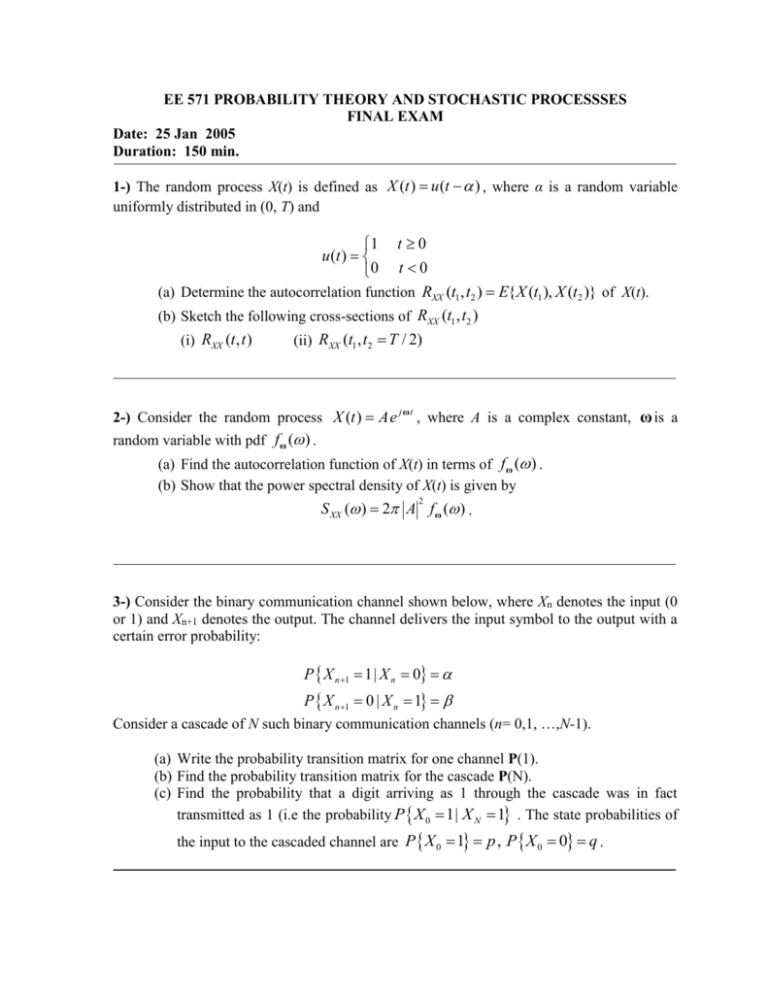
EE 571 PROBABILITY THEORY AND STOCHASTIC PROCESSSES
FINAL EXAM
Date: 25 Jan 2005
Duration: 150 min.
1-) The random process X(t) is defined as X (t ) u (t ) , where α is a random variable
uniformly distributed in (0, T) and
t0
t0
(a) Determine the autocorrelation function RXX (t1 , t2 ) E{ X (t1 ), X (t2 )} of X(t).
(b) Sketch the following cross-sections of RXX (t1 , t2 )
1
u (t )
0
(i) RXX (t , t )
(ii) RXX (t1 , t2 T / 2)
j ωt
2-) Consider the random process X (t ) Ae , where A is a complex constant, ω is a
random variable with pdf fω ( ) .
(a) Find the autocorrelation function of X(t) in terms of fω ( ) .
(b) Show that the power spectral density of X(t) is given by
S XX ( ) 2 A f ω ( ) .
2
3-) Consider the binary communication channel shown below, where Xn denotes the input (0
or 1) and Xn+1 denotes the output. The channel delivers the input symbol to the output with a
certain error probability:
P X n 1 1| X n 0
P X n 1 0 | X n 1
Consider a cascade of N such binary communication channels (n= 0,1, …,N-1).
(a) Write the probability transition matrix for one channel P(1).
(b) Find the probability transition matrix for the cascade P(N).
(c) Find the probability that a digit arriving as 1 through the cascade was in fact
transmitted as 1 (i.e the probability P X 0 1| X N 1 . The state probabilities of
the input to the cascaded channel are P X 0 1 p , P X 0 0 q .
0
1-α
0
β
Xn
Xn+1
α
1
1
1-β
4-) Consider a homogeneous Poisson process X(t) such that E{X(9)}=18.
(a) Find the mean and variance of X(8).
(b) Find P X (2) 3 .
(c) Find P X (4) 5 | X (2) 3. (Hint: use the fact that the Poisson process has
independent increments)
5-) A LTI continuous-time system has impulse response
e4t
h(t )
0
t 0
t 0
The input to the system X(t) is a random process with autocorrelation RXX ( ) e
(a) Find the power spectral density SYY ( f ) of the output Y(t) .
(b) Find the average power of the output.
2
.
SOLUTION
1-) (a)
RXX (t1 , t2 ) E u (t1 α ) u (t2 α )
u (t
1
) u (t2 ) f α ( )d
T
1
u(t1 ) u(t2 ) d
T 0
0
t1
= tT2
T
1
t1 0 or t2 0
0 t1 T t2 >t1
0 t2 T t1 >t2
t1 , t2 >T
(c) (i)
0
RXX (t , t ) Tt
1
t0
0t T
t T
1
t
T
(ii)
Tt1
RXX (t1 , t2 T / 2) 12
0
t1 T / 2
t1 T / 2
t1 0
1/2
T/2
2-) (a)
RXX ( ) E X * (t ) X (t ) E A*e j ω t Ae j ω (t )
A E e j ω A
2
2
e
j
f ω ( )d
t
(b)
RXX ( ) in terms of the power spectral density is
1
RXX ( )
2
S
XX
( )e j d
Comparing with the expression in part (a), the uniqueness property of
Fourier transforms gives
S XX ( ) 2 A fω ( )
2
3-) (a)
1
P(1)
1
(b) From lecture notes
P( N ) P(1) N
1
(c)
P X 0 1| X N 1
(1 ) N
N
(1 )
(1 ) N
(1 ) N
P X N 1| X 0 1 .P{ X 0 1} P11 (0, N ). p1 (0)
P{ X N 1}
p1 ( N )
where P11 (0, N ) is the transition probability
(1 ) N
The state probabilities are
p1 (0) p
p1 ( N ) P01 (0, N ). p0 (0) P11 (0, N ). p1 (0)
P11 (0, N )
(1 ) N
(1 ) N
q
p
p q
( p q)
(1 ) N
p1 ( N )
p q 1
P X 0 1| X N 1
[ (1 ) N ] p
( p q)(1 ) N
4-) (a) E{X(t)}= λt = 18
λ= 18/9 =2
t=9
E{X(8)}= 8×2 = 16
Var{X(8)}= λt = 16
(t )k t 3 (4)k 4 4
P X (2) 3
e
e e [1 1!4 162! 64
3! ] 0.4335
k 0 k !
k 0 k !
3
(b)
(c)
Let Y X (2) , Z X (4) X (2) X (4) Y
X (4) 5
Z Y 5 ,
P Z Y 5 | Y 3
P Y k
4k 4
e
k!
Y and Z are independent Poisson random variables.
P Z Y 5, Y 3
P Y 3
P Z n
and
4n 4
e
n!
P Y k , Z n
4n k
k 0 n 0 n !k !
3 5 k
3 5 k
P Z Y 5, Y 3 P Y k , Z n e 8
k 0 n 0
2
5 4n 4 4n 1 3 4n 2
4n 3
e
n 0 n ! n 0 n ! n 0 2(n !) n 0 6(n !)
0.1705
8
P Z Y 5 | Y 3
0.1705
0.3933
0.4335
5-) (a)
SYY ( f ) S XX ( f ) H ( f )
2
H ( f ) h(t )e j 2 ft dt e (4 j 2 f )t dt
0
0
S XX ( f ) e
0
2
e j 2 f d
1
4 j 2 f
4
4 (2 f ) 2
4
1
SYY ( f )
2
2
4 (2 f ) 16 (2 f )
4n k 8
e
n !k !
(b)
E{Y (t )}
2
S
YY
( f )df
s j 2 f
E{Y (t )}
2
j
c ( s )c ( s )
ds
2 j j d ( s )d ( s )
1
c( s ) c( s )
2
2
4 1
SYY ( s )
2
2
4 s 16 s (2 s)(4 s) (2 s)(4 s) d ( s) d ( s)
c( s ) 2 c0 2 c1 0
d ( s) s 2 6s 8
E{Y 2 (t )}
d0 8
d1 6
c12 d 0 c02 d 2
4
1
2d 0 d1d 2
2 8 6 24
d2 1
